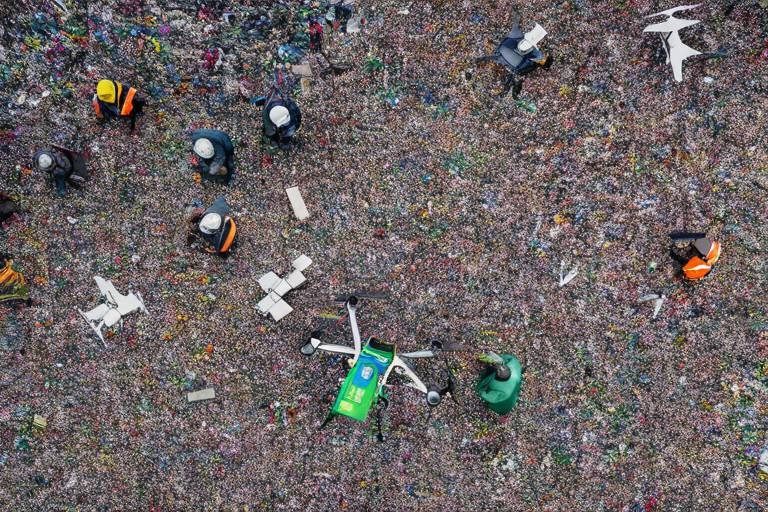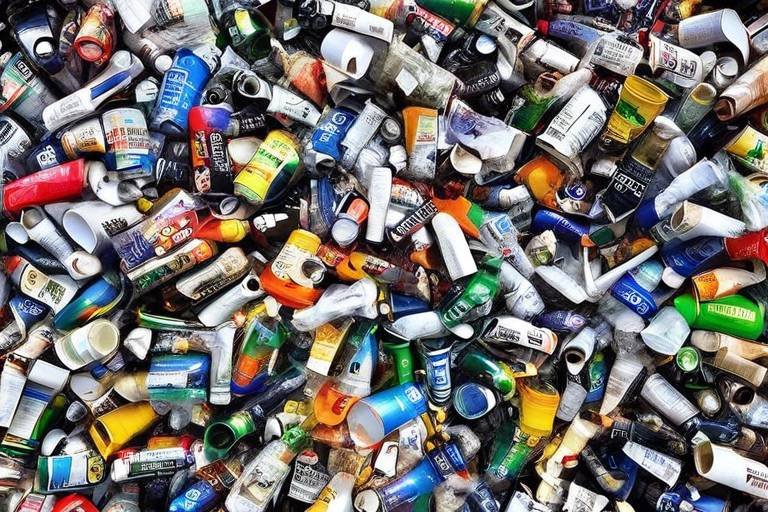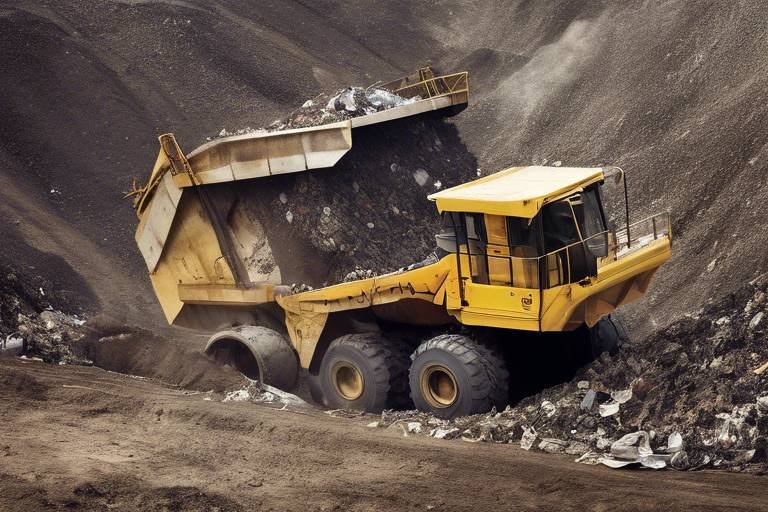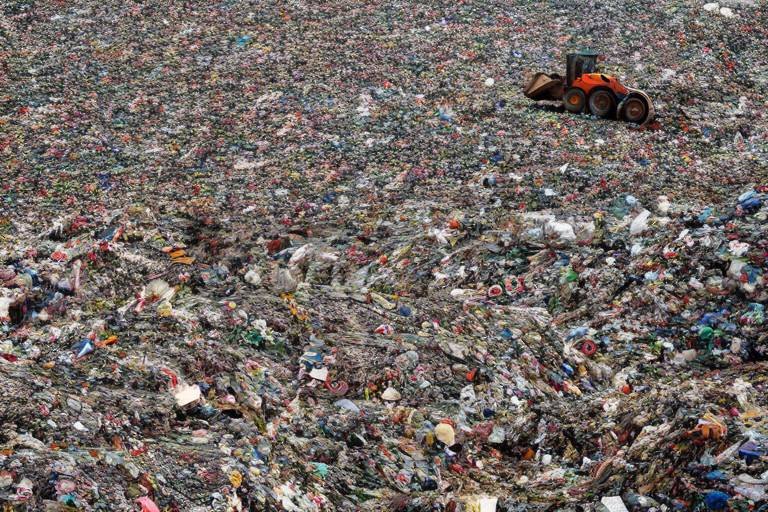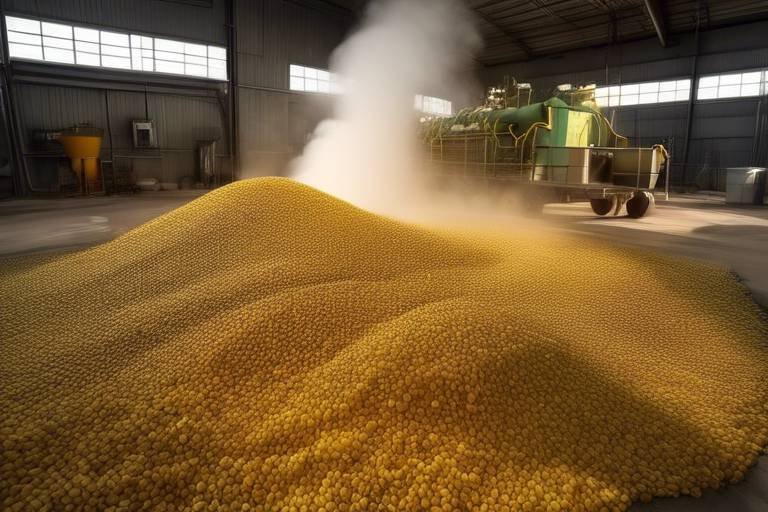The Use of Drones in Waste Management
In recent years, the integration of drones into various industries has sparked a revolution, and waste management is no exception. Imagine a world where waste collection is not only efficient but also environmentally friendly. Drones are leading the charge in this transformation, offering innovative solutions that enhance operational efficiency while minimizing the ecological footprint. As urban areas continue to expand and the amount of waste generated increases, the need for smarter waste management practices becomes paramount. This article delves into the multifaceted role of drones in waste management, highlighting their remarkable benefits, diverse applications, and the exciting future they promise for sustainable urban living.
Drones offer numerous advantages in waste management, making them a game-changer in the industry. One of the primary benefits is cost reduction. By utilizing drones for monitoring and data collection, waste management companies can significantly cut down on labor costs and operational expenses. Furthermore, drones enhance monitoring capabilities, allowing for real-time insights into waste levels and collection needs. This leads to more efficient route planning and scheduling, ensuring that resources are allocated where they are most needed.
Another crucial benefit is the improved safety for workers. Traditional waste management often involves hazardous environments, but drones can access hard-to-reach areas without putting personnel at risk. This not only protects workers but also enhances the overall effectiveness of waste operations. With the ability to gather data from challenging locations, drones provide a comprehensive view of waste management operations, enabling better decision-making and strategic planning.
Drones are increasingly being utilized for waste collection, revolutionizing how we approach this essential service. By enabling real-time data gathering, drones facilitate efficient route planning that optimizes collection schedules. This technology allows waste management companies to adapt quickly to changing conditions, such as unexpected increases in waste generation or changes in traffic patterns.
Moreover, drones can be equipped with advanced sensors and cameras that capture high-resolution images and data. This capability not only streamlines the collection process but also reduces operational costs significantly. For instance, a drone can survey an entire neighborhood in a matter of minutes, identifying areas that require immediate attention and thus ensuring that waste is collected promptly.
Using drones to monitor landfills provides accurate data on waste volumes and environmental impact. This technology aids in compliance with regulations and enhances the management of landfill operations. By conducting aerial surveys, drones can assess the condition of landfill sites, monitor for illegal dumping, and provide valuable insights into how waste is being managed.
Drones facilitate environmental impact assessments by providing aerial surveys of landfill sites. This information helps in evaluating potential risks and developing strategies for waste mitigation. With the ability to gather data over vast areas quickly, drones can identify environmental hazards, such as leachate leaks or methane emissions, that may pose risks to nearby communities.
Real-time data collection through drone technology allows for timely decision-making in waste management. This capability improves operational efficiency and helps in addressing environmental concerns swiftly. For example, if a drone detects an overflow in a waste bin, the waste management team can respond immediately, preventing littering and maintaining community cleanliness.
Drones are being integrated into recycling processes, helping to identify and sort recyclable materials more effectively. This innovation enhances recycling rates and promotes sustainable practices in waste management. By utilizing drones equipped with machine learning algorithms, companies can automate the sorting process, leading to more efficient recycling operations.
Despite their benefits, the implementation of drones in waste management faces challenges such as regulatory hurdles, technical limitations, and public acceptance. Addressing these issues is crucial for widespread adoption. For instance, navigating regulatory frameworks is essential for the successful deployment of drones in waste management. Understanding local laws and obtaining necessary permits can be a complex process for operators.
Navigating regulatory frameworks is essential for the successful deployment of drones in waste management. Understanding local laws and obtaining necessary permits can be a complex process for operators. Regulations vary significantly from one region to another, creating a patchwork of rules that can complicate operations.
Technical limitations, including battery life and payload capacity, can hinder the effectiveness of drones in waste management. Continuous advancements in technology are necessary to overcome these challenges. As battery technology improves and drones become more capable, we can expect to see even greater integration of drones in waste management practices.
- How do drones improve waste collection efficiency? Drones provide real-time data that helps in optimizing collection routes and schedules, reducing operational costs.
- What are the safety benefits of using drones in waste management? Drones can access hazardous areas without putting workers at risk, enhancing overall safety.
- Are there regulatory challenges to using drones? Yes, operators must navigate complex local laws and obtain necessary permits for drone operations.
- How can drones aid in recycling efforts? Drones can automate the sorting of recyclable materials, improving recycling rates.

Benefits of Drones in Waste Management
This article explores the innovative role of drones in waste management, highlighting their benefits, applications, and future potential in improving efficiency and sustainability in urban environments.
Drones are rapidly transforming the landscape of waste management, offering a multitude of benefits that traditional methods simply can't compete with. Imagine a world where waste collection is not just efficient but also cost-effective and safe. That's the promise drones bring to the table. One of the most significant advantages is the cost reduction they offer. By utilizing drones, waste management companies can minimize their operational expenses significantly. For instance, drones can cover large areas in a fraction of the time it would take a traditional vehicle, cutting down on fuel and labor costs.
Moreover, drones enhance monitoring capabilities, allowing for real-time data collection and analysis. This means that waste management teams can make informed decisions on the fly, optimizing their routes and schedules based on current conditions. Picture a drone soaring over a city, gathering data on waste levels in various bins, and relaying that information back to the control center. This level of precision ensures that resources are allocated where they are needed most, reducing the risk of overflowing bins and unsightly litter.
Another critical benefit is the improved safety for workers. Waste management can be a hazardous job, with workers often facing dangerous conditions. Drones can take on the more perilous tasks, such as inspecting hard-to-reach areas or monitoring landfill sites, thereby reducing the risk of accidents. For example, instead of sending a crew into a potentially hazardous landfill environment, a drone can perform the same task, ensuring that workers remain safe while still getting the job done.
Furthermore, drones can access hard-to-reach areas that traditional vehicles might struggle with. Whether it's a remote location or an urban area with narrow streets, drones can navigate effortlessly, ensuring that no waste goes uncollected. This capability is especially crucial in urban environments where congestion can hinder waste collection efforts. The agility of drones allows for a more comprehensive waste management strategy that adapts to the unique challenges of each location.
In summary, the benefits of using drones in waste management are profound and multifaceted. From cost savings and enhanced monitoring to improved safety and accessibility, drones are paving the way for a more efficient and sustainable approach to waste management. As this technology continues to evolve, we can expect even more innovative applications that will further revolutionize how we handle waste in our communities.
- How do drones improve waste collection efficiency? Drones optimize routes and schedules by providing real-time data on waste levels, allowing waste management companies to allocate resources more effectively.
- Are there safety concerns associated with using drones in waste management? While there are safety concerns with any technology, drones can actually enhance worker safety by taking on hazardous tasks and reducing the need for human intervention in dangerous areas.
- What are the regulatory challenges for drone usage in waste management? Operators must navigate local laws and obtain necessary permits, which can be complex and vary by location, posing a challenge for widespread adoption.
- Can drones help with recycling efforts? Yes, drones can identify and sort recyclable materials more effectively, enhancing recycling rates and promoting sustainable practices.

Applications of Drones in Waste Collection
Drones are revolutionizing the waste management industry, especially in the realm of waste collection. Imagine a world where waste is collected with the precision of a surgeon—this is the future that drones are paving the way for. These flying marvels are not just for delivering packages or capturing stunning aerial shots; they are becoming essential tools in optimizing waste collection processes. One of the most significant advantages drones offer is their ability to gather real-time data, which is crucial for efficient route planning. With the help of advanced sensors and GPS technology, drones can map out the most effective paths for waste collection trucks, significantly reducing fuel consumption and time spent on the road.
Furthermore, drones can access hard-to-reach areas that traditional waste collection vehicles might struggle with. Think about those narrow alleyways in urban environments or remote locations that are often overlooked during regular collection schedules. Drones can swoop in and assess these locations, ensuring that no waste is left behind. This capability not only enhances the overall efficiency of waste management operations but also contributes to a cleaner and more sustainable environment.
In addition to route optimization, drones are also equipped to collect data regarding the types and amounts of waste generated in different areas. This information is invaluable for waste management companies as it allows them to tailor their services based on specific community needs. For instance, if a particular neighborhood is generating a significant amount of recyclable materials, companies can adjust their collection strategies accordingly. This data-driven approach not only improves operational efficiency but also promotes responsible waste disposal practices among residents.
Moreover, the integration of drones into waste collection processes can lead to substantial cost savings. By minimizing the time and resources spent on waste collection, companies can redirect those savings towards other essential services or community initiatives. In an era where sustainability is paramount, drones provide a pathway to not only enhance operational efficiency but also to foster a culture of environmental responsibility.
To summarize, the applications of drones in waste collection are vast and varied. From real-time data gathering to efficient route planning and enhanced access to hard-to-reach areas, drones are transforming how waste management companies operate. As technology continues to evolve, we can expect even more innovative applications that will further improve the efficiency and sustainability of waste collection processes.
- How do drones optimize waste collection routes?
Drones use GPS and advanced sensors to gather real-time data, enabling them to identify the most efficient paths for waste collection trucks. - Can drones access difficult areas for waste collection?
Yes, drones can reach narrow alleyways and remote locations that traditional waste collection vehicles may find challenging. - What kind of data can drones collect during waste management operations?
Drones can gather information on the types and amounts of waste generated, which helps companies tailor their services to community needs. - Are drones cost-effective for waste management companies?
Absolutely! By reducing the time and resources spent on waste collection, drones can lead to significant cost savings for companies.

Monitoring Landfills with Drones
In the realm of waste management, drones have emerged as a groundbreaking solution for monitoring landfills. Imagine having the ability to survey vast areas of waste without the need for extensive manpower or cumbersome equipment. Drones equipped with high-resolution cameras and sensors can fly over landfill sites, capturing detailed images and data that provide insights into waste volumes and environmental impacts. This capability not only enhances operational efficiency but also ensures compliance with regulatory standards.
One of the primary benefits of using drones for landfill monitoring is their ability to access hard-to-reach areas. Traditional monitoring methods often require personnel to navigate through hazardous environments, which can pose safety risks. Drones, on the other hand, can effortlessly glide over uneven terrain, steep slopes, and even hazardous zones, collecting data from a safe distance. This not only protects workers but also allows for more comprehensive surveys, as drones can cover large areas in a fraction of the time it would take a ground crew.
Furthermore, the data collected by drones can be processed using sophisticated software to generate 3D models of the landfill site. These models provide a visual representation of the waste landscape, allowing managers to assess changes over time and make informed decisions regarding waste management strategies. By comparing data from different time periods, operators can identify trends, such as waste accumulation rates or potential environmental threats, enabling proactive measures to mitigate risks.
To illustrate the effectiveness of drone monitoring, consider the following table that summarizes key advantages:
| Advantage | Description |
|---|---|
| Safety | Drones reduce the need for personnel to enter hazardous areas, minimizing safety risks. |
| Efficiency | They can cover large areas quickly, saving time and labor costs. |
| Data Accuracy | High-resolution imaging provides precise measurements of waste volumes and site conditions. |
| Regulatory Compliance | Enhanced monitoring helps ensure adherence to environmental regulations. |
Moreover, drones can assist in environmental impact assessments by capturing aerial surveys of landfill sites. This data becomes invaluable in evaluating potential risks such as leachate leakage or methane emissions. By conducting regular aerial inspections, waste management companies can develop strategies for waste mitigation and ensure that they are operating within the legal frameworks set by environmental agencies.
In conclusion, the use of drones for monitoring landfills is a game-changer in waste management. Their ability to provide real-time data, ensure safety, and enhance compliance with regulations makes them an essential tool for modern waste operations. As technology continues to evolve, we can expect even more innovative applications for drones in the waste management sector, paving the way for a more sustainable future.

Environmental Impact Assessments
Environmental impact assessments (EIAs) play a pivotal role in understanding how waste management activities affect the surrounding ecosystem. With the integration of drone technology, conducting these assessments has become significantly more efficient and effective. Drones equipped with high-resolution cameras and sensors can capture detailed aerial imagery of landfill sites, allowing for a comprehensive overview of the area in question.
Imagine trying to measure the environmental impact of a landfill from the ground; it’s like trying to find a needle in a haystack. Drones, however, provide a bird's-eye view, enabling waste management professionals to identify potential environmental hazards and assess the overall condition of the site with remarkable accuracy. This capability is essential for evaluating factors such as:
- Waste Volume: Drones can quickly survey the size and layout of a landfill, helping to estimate the volume of waste and identify areas that may require immediate attention.
- Leachate Management: Monitoring leachate, a toxic liquid that can seep from landfills, is critical. Drones can identify areas where leachate may be pooling or leaking, allowing for prompt action to mitigate risks.
- Vegetation Health: By analyzing the health of vegetation surrounding landfill sites, drones can help determine the impact of waste on local flora, which is essential for biodiversity preservation.
Moreover, the data collected by drones can be used to create detailed reports that are essential for regulatory compliance. These reports not only facilitate adherence to environmental regulations but also serve as an invaluable resource for stakeholders, including local communities and environmental agencies. By providing transparent and accurate data, drones help build trust and foster collaboration between waste management companies and the public.
As we move toward a more sustainable future, the role of drones in environmental impact assessments will only grow. Their ability to provide real-time data and insights empowers waste management professionals to make informed decisions that prioritize environmental protection while ensuring efficient waste operations. In essence, drones are not just tools; they are essential partners in the quest for sustainability in waste management.
- What are environmental impact assessments? EIAs are processes used to evaluate the potential environmental effects of proposed projects or activities, ensuring that decision-makers consider environmental impacts before proceeding.
- How do drones improve environmental impact assessments? Drones provide high-resolution aerial imagery and real-time data, allowing for more accurate assessments of waste management practices and their effects on the environment.
- Are there regulatory requirements for using drones in EIAs? Yes, operators must adhere to local regulations regarding drone usage, including obtaining necessary permits and ensuring compliance with safety standards.

Real-time Data Collection
In the fast-paced world of waste management, has emerged as a game-changer, providing critical insights that can significantly enhance operational efficiency. Imagine being able to monitor waste levels, track collection routes, and assess environmental impacts all in real-time—this is precisely what drone technology offers. By leveraging advanced sensors and imaging capabilities, drones can capture and transmit data instantaneously, allowing waste management companies to make informed decisions on the fly.
One of the most compelling aspects of real-time data collection through drones is the ability to respond swiftly to changing conditions. For instance, if a drone identifies an overflowing bin or a hazardous waste spill, operators can be alerted immediately, ensuring that issues are addressed before they escalate. This proactive approach not only enhances safety but also minimizes the potential for environmental harm.
Furthermore, the data collected by drones can be analyzed to optimize waste collection routes. By employing sophisticated algorithms, waste management companies can determine the most efficient paths for their collection vehicles, reducing fuel consumption and operational costs. Picture a scenario where a drone maps out the quickest route to collect waste from multiple locations, saving time and resources—this is the future of waste management.
To illustrate the impact of real-time data collection, consider the following table:
| Data Collected | Benefits |
|---|---|
| Waste Volume | Helps in planning collection schedules and reducing overflow incidents. |
| Environmental Conditions | Enables quick responses to potential hazards, improving safety. |
| Route Efficiency | Reduces operational costs and enhances service delivery. |
In addition to these benefits, real-time data collection fosters a culture of transparency and accountability. Stakeholders, including local governments and the community, can access data regarding waste management practices, leading to increased trust and collaboration. As we move towards a more sustainable future, the integration of drone technology in waste management is not just beneficial; it is essential.
- How do drones collect real-time data? Drones are equipped with advanced sensors and cameras that capture data on waste levels, environmental conditions, and more, transmitting this information back to operators instantly.
- What are the main advantages of using drones for waste management? Drones improve efficiency, reduce operational costs, enhance safety, and provide real-time insights that help in making informed decisions.
- Are there any regulations regarding the use of drones in waste management? Yes, operators must adhere to local laws and obtain necessary permits, which can vary by region.

Drone Technology in Recycling
In recent years, the integration of drones into the recycling process has revolutionized how we approach waste management. These flying marvels are not just toys for tech enthusiasts; they are becoming vital tools that enhance the efficiency and effectiveness of recycling operations. Imagine a world where sorting through mountains of waste is no longer a back-breaking chore but a streamlined process powered by cutting-edge technology. That's the promise of drone technology in recycling.
One of the most significant advantages of using drones in recycling is their ability to identify and sort recyclable materials with remarkable precision. Equipped with advanced imaging technology, drones can quickly scan large areas and identify materials like plastics, metals, and paper. This capability allows recycling facilities to optimize their sorting processes, ensuring that valuable materials are not lost in the waste stream. For instance, a drone can fly over a landfill or recycling center, capturing high-resolution images that are analyzed using artificial intelligence algorithms to determine the types of materials present.
Furthermore, drones can assist in monitoring recycling bins in urban areas. By utilizing real-time data collection, drones can identify when bins are full or need to be emptied. This not only improves the efficiency of waste collection routes but also minimizes overflow and littering, creating cleaner urban environments. Think of it as having a bird's-eye view of your neighborhood's recycling habits, allowing waste management companies to respond swiftly and effectively to community needs.
Additionally, the data collected by drones can be invaluable for educational purposes. By analyzing the types of materials that are frequently found in recycling bins, municipalities can tailor their public awareness campaigns to address specific issues. For example, if a drone survey reveals that a significant amount of non-recyclable materials is being placed in recycling bins, targeted outreach can help educate residents on proper recycling practices.
However, the integration of drone technology into recycling is not without its challenges. As with any new technology, there are concerns regarding privacy and data security. It's crucial for operators to adhere to strict guidelines to ensure that the data collected is used responsibly and does not infringe on individuals' privacy. Moreover, the initial investment in drone technology can be substantial, and companies must weigh the costs against the potential benefits.
As we look to the future, the potential for drones in recycling is immense. With ongoing advancements in drone technology, including improvements in battery life and payload capacity, we can expect to see even greater applications in waste management. Drones could soon become standard tools in recycling operations, helping to create a more sustainable and efficient waste management system.
- How do drones help in recycling? Drones assist in identifying and sorting recyclable materials, monitoring recycling bins, and collecting data for educational purposes.
- Are there any privacy concerns with drone usage? Yes, there are privacy and data security concerns that must be addressed to ensure responsible use of drone technology.
- What are the challenges of using drones in recycling? Challenges include regulatory hurdles, initial investment costs, and technical limitations such as battery life.
- Can drones improve the efficiency of waste collection? Absolutely! Drones can provide real-time data that optimizes waste collection routes and schedules.

Challenges of Implementing Drones
While the integration of drones into waste management systems brings a plethora of benefits, it's essential to recognize the challenges that accompany this innovative technology. One of the most significant hurdles is navigating the complex web of regulatory frameworks. Different regions have varying laws governing drone operations, which can make it daunting for waste management companies to deploy these technologies effectively. For instance, operators must often secure multiple permits and adhere to specific guidelines that may differ from one jurisdiction to another. This can lead to delays in implementation and increased costs.
In addition to regulatory challenges, there are also technical limitations that can impact the effectiveness of drones in waste management. Issues such as battery life and payload capacity are critical factors that need to be addressed. Most drones currently on the market have limited flight times, often ranging from 20 to 40 minutes, depending on their weight and the conditions in which they are operating. This limitation can restrict the distance and area that can be effectively monitored or serviced. Moreover, the payload capacity of many drones may not be sufficient for transporting larger waste items, which means that their role in collection may be limited to smaller, less hazardous materials.
Public acceptance is another critical challenge that cannot be overlooked. Many people may be unaware of the benefits that drones can bring to waste management and might harbor concerns regarding privacy and safety. Building trust within the community is essential for the successful adoption of drone technology. Waste management companies must engage with the public, providing clear information about how drones operate, the safety measures in place, and the positive environmental impacts they can facilitate. This kind of outreach can help alleviate fears and foster a more accepting attitude towards drone usage.
To summarize, while the deployment of drones in waste management holds great promise, overcoming the challenges of regulatory hurdles, technical limitations, and public acceptance is crucial. Addressing these issues will not only enhance operational efficiency but also ensure that the technology is embraced by all stakeholders involved.
- What are the primary benefits of using drones in waste management?
Drones can significantly reduce operational costs, enhance monitoring capabilities, and improve safety for workers by accessing hard-to-reach areas. - How do drones help in monitoring landfills?
Drones provide accurate data on waste volumes and environmental impact, aiding compliance with regulations and improving landfill management. - What are the main regulatory challenges faced by drone operators?
Operators must navigate complex local laws and obtain necessary permits, which can vary significantly from one area to another. - Are there any technological limitations to consider?
Yes, battery life and payload capacity are significant factors that can limit the effectiveness of drones in waste management operations. - How can public acceptance of drone technology be improved?
Engaging with the community and providing clear information about the benefits and safety measures of drone usage can help build trust and acceptance.

Regulatory Hurdles
When it comes to incorporating drones into waste management, one of the most significant challenges lies in navigating the complex web of . Different countries, states, and even municipalities have their own set of laws governing the use of drones. This can create a daunting landscape for waste management companies looking to adopt this innovative technology. Imagine trying to drive a car without knowing the traffic rules; that's how it feels for operators attempting to deploy drones without a clear understanding of local regulations.
First and foremost, operators must familiarize themselves with aviation regulations. In many regions, flying drones for commercial purposes requires specific licenses and adherence to safety protocols. For instance, the Federal Aviation Administration (FAA) in the United States has established guidelines that must be followed, such as maintaining a certain altitude and avoiding populated areas. These regulations are in place to ensure public safety, but they can also slow down the adoption of drone technology in waste management.
Moreover, the process of obtaining the necessary permits can be lengthy and complicated. Waste management companies often find themselves entangled in bureaucratic red tape, which can delay the implementation of drone services. For example, in some jurisdictions, operators may need to conduct environmental impact assessments before they can even start flying. This not only takes time but also requires additional resources, diverting attention from the core business of waste management.
Another aspect to consider is the public perception of drones. Many people are still wary of drone technology, associating it with privacy violations or safety concerns. This skepticism can lead to resistance from local communities, making it even more challenging for companies to gain the necessary approvals to operate drones. To mitigate these concerns, companies must engage in community outreach and education efforts, explaining the benefits of using drones for waste management, such as increased efficiency and reduced environmental impact.
In summary, while the potential for drones in waste management is enormous, the regulatory landscape presents a significant barrier to entry. Companies must be prepared to invest time and resources into understanding and navigating these regulations. By doing so, they can not only facilitate the adoption of drone technology but also contribute to a more sustainable future.
- What are the main regulatory challenges for drones in waste management?
Operators must navigate complex aviation regulations, obtain necessary permits, and address public concerns regarding safety and privacy. - How can waste management companies overcome these hurdles?
Engaging in community outreach, investing in regulatory knowledge, and collaborating with local authorities can help ease the process. - Are there specific licenses required to operate drones commercially?
Yes, in many regions, operators need to obtain specific licenses and adhere to safety protocols set by aviation authorities. - What are the benefits of using drones in waste management?
Drones can enhance monitoring capabilities, improve safety for workers, optimize collection schedules, and provide real-time data for better decision-making.

Technical Limitations
While the use of drones in waste management presents exciting opportunities, it's essential to acknowledge the that can impede their effectiveness. One of the most significant challenges is battery life. Drones typically have limited flight times, often ranging from 20 to 30 minutes, depending on the model and payload. This restriction means that for larger waste management operations, multiple drones might be required to cover extensive areas, which can complicate logistics and increase costs.
Another critical factor is the payload capacity of drones. Most commercial drones are designed to carry lightweight equipment, which limits their ability to transport heavy waste materials directly. This limitation necessitates the use of drones primarily for data collection rather than for the physical removal of waste. Consequently, while they can identify areas that need attention, the actual collection process still relies heavily on traditional methods.
In addition to battery life and payload capacity, the environmental conditions in which drones operate can also pose challenges. High winds, rain, and extreme temperatures can affect a drone's performance, leading to potential safety hazards. For instance, flying a drone in windy conditions can result in unstable flight paths, making it difficult to gather accurate data or navigate to specific locations. Operators must be trained to assess weather conditions properly before deployment, adding another layer of complexity to drone operations.
Furthermore, there are technical skills required for effective drone operation. Waste management personnel may need additional training to operate drones, analyze the data collected, and integrate this information into existing waste management systems. This requirement can be a barrier for some companies, especially smaller ones that may not have the resources to invest in specialized training.
To summarize, while drones offer significant potential in waste management, their effectiveness is currently hampered by:
- Battery Life: Limited flight durations restrict operational capabilities.
- Payload Capacity: Inability to transport heavy waste materials directly.
- Environmental Conditions: Weather can adversely affect drone performance.
- Technical Skills: Need for specialized training for personnel.
Addressing these technical limitations is crucial for the future of drone technology in waste management. As advancements continue to be made in battery technology, payload capabilities, and user training, we can expect to see drones playing an even more prominent role in making waste management processes more efficient and sustainable.
Q1: How long can drones fly on a single charge?
A1: Most commercial drones have a flight time of 20 to 30 minutes, depending on the model and payload.
Q2: Can drones collect waste directly?
A2: Currently, drones are primarily used for data collection and monitoring rather than for the physical collection of waste due to their payload limitations.
Q3: What environmental conditions affect drone operations?
A3: High winds, rain, and extreme temperatures can impact a drone's performance and stability during flight.
Q4: Is specialized training required for drone operators in waste management?
A4: Yes, personnel may need additional training to effectively operate drones and analyze the data they collect.
Frequently Asked Questions
- What are the main benefits of using drones in waste management?
Drones offer a variety of benefits in waste management, including significant cost reductions, enhanced monitoring capabilities, and improved safety for workers. Their ability to access hard-to-reach areas allows waste management companies to operate more efficiently and effectively.
- How do drones improve waste collection processes?
Drones are revolutionizing waste collection by enabling real-time data gathering and efficient route planning. This technology allows waste management companies to optimize collection schedules, which ultimately leads to reduced operational costs and improved service delivery.
- Can drones be used to monitor landfills?
Absolutely! Drones are increasingly used to monitor landfills, providing accurate data on waste volumes and environmental impacts. This information is crucial for compliance with regulations and helps enhance the overall management of landfill operations.
- What role do drones play in environmental impact assessments?
Drones facilitate environmental impact assessments by conducting aerial surveys of landfill sites. These surveys help in evaluating potential risks and developing effective strategies for waste mitigation, ensuring that environmental concerns are addressed promptly.
- How does real-time data collection through drones benefit waste management?
Real-time data collection allows waste management companies to make timely decisions, improving operational efficiency. With immediate access to critical information, companies can swiftly address environmental concerns and optimize their waste management strategies.
- Are drones effective in the recycling process?
Yes, drones are being integrated into recycling processes to help identify and sort recyclable materials more effectively. This innovation not only enhances recycling rates but also promotes sustainable practices within the waste management industry.
- What challenges do companies face when implementing drones in waste management?
Despite their benefits, companies encounter several challenges when implementing drones, including regulatory hurdles, technical limitations, and public acceptance. Addressing these issues is essential for the successful and widespread adoption of drone technology in waste management.
- What are the regulatory hurdles associated with drone usage in waste management?
Navigating the regulatory landscape is crucial for deploying drones in waste management. Operators must understand local laws and obtain the necessary permits, which can often be a complex and time-consuming process.
- What technical limitations do drones face in waste management?
Technical limitations, such as battery life and payload capacity, can hinder the effectiveness of drones in waste management. Continuous advancements in drone technology are necessary to overcome these challenges and enhance their operational capabilities.

